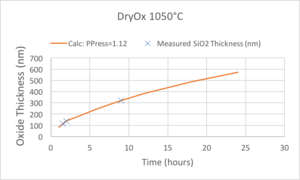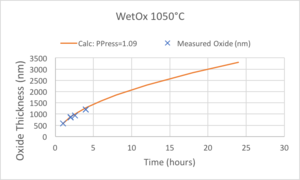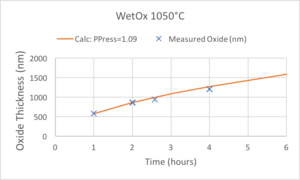Thermal Processing Recipes: Difference between revisions
m (→1050°C Dry Oxidation: correction to pressures) |
(Updated thermal ox Recipe names, added Logitech Bonder, Finetech Bonder, Tystar AlGaAs, Lindberg AlGaAs basic info.) |
||
| Line 1: | Line 1: | ||
==Tystar 8300== |
==[[Tube Furnace (Tystar 8300)|Tystar 8300]]== |
||
=== Thermal Oxidation of Silicon === |
=== Thermal Oxidation of Silicon - Calculating Oxidation Times === |
||
Online calculators for thermal oxidation can be used to estimate the oxidation time for a desired oxidation thickness. |
Online calculators for thermal oxidation can be used to estimate the oxidation time for a desired oxidation thickness. |
||
Please see the [[Calculators + Utilities]] page for links to these oxidation calculators. |
Please see the [[Calculators + Utilities]] page for links to these oxidation calculators. |
||
Using the [http://www.lelandstanfordjunior.com/thermaloxide.html Stanford Leland Jr. "Advanced Silicon Thermal Oxide Thickness Calculator"], we have determined the following simulation parameters to predict oxidation times. |
Using the [http://www.lelandstanfordjunior.com/thermaloxide.html Stanford Leland Jr. "Advanced Silicon Thermal Oxide Thickness Calculator"], we have determined the following simulation parameters to predict oxidation times. Pleas enote, however, that doping level, impurity concentration and other factors can alter these calibrations, so you may need to calibrate the ''Partial Pressure'' yourself if you need higher accuracy. |
||
=== Thermal Oxidation Recipes === |
|||
==== 1050°C Dry Oxidation ==== |
==== 1050°C Dry Oxidation ==== |
||
* Recipe Name: '''''DRY1050''''' |
|||
* Tube #2 for Cleaned Silicon Only |
|||
* Tube #3 for processed silicon or other anneals. |
|||
===== Simulation Parameters ===== |
|||
* Partial Pressure = 1.12 |
* Partial Pressure = 1.12 |
||
* <100>, 1050°C, 10Å Native Oxide, no dopants |
* <100>, 1050°C, 10Å Native Oxide, no dopants |
||
[[File:TyStar_Thermal_Oxidations_-_DryOx_1050°C_2018-04-09.png|alt=plot of Measurements and Curve-Fitting for 1050°C Dry oxidations.|none|thumb|300x300px|'''Measurements and Curve-Fitting for 1050°C Dry oxidations. Note: three data points only.''']] |
|||
[[File:TyStar Thermal Oxidations - DryOx 1050°C 2018-04-09.png|frameless|300x300px]] |
|||
==== 1050°C Wet Oxidation ==== |
==== 1050°C Wet Oxidation ==== |
||
* Recipe Name: '''''WET1050''''' |
|||
* Tube #2 for Cleaned Silicon Only |
|||
* Tube #3 for processed silicon or other anneals. |
|||
===== Simulation Parameters ===== |
|||
* Partial Pressure = 1.09 |
* Partial Pressure = 1.09 |
||
* <100>, 1050°C, 10Å Native Oxide, no dopants |
* <100>, 1050°C, 10Å Native Oxide, no dopants |
||
{| |
{| |
||
![[File:TyStar_Thermal_Oxidations_-_WetOx_1050°C_2018-04-09.png|alt=plot of Measurements and Curve-Fitting for 1050°C Wet oxidations.|none|thumb|300x300px|Measurements and Curve-Fitting for 1050°C Wet oxidations.]] |
|||
![[File:TyStar Thermal Oxidations - WetOx 1050°C 2018-04-09.png|frameless|300x300px]] |
|||
![[File:TyStar_Thermal_Oxidations_-_WetOx_1050°C_2018-04-09_zoom.png|alt=plot of Zoom-in on Measurements and Curve-Fitting for 1050°C Wet oxidations.|none|thumb|300x300px|Zoom-in on Measurements and Curve-Fitting for 1050°C Wet oxidations.]] |
|||
![[File:TyStar Thermal Oxidations - WetOx 1050°C 2018-04-09 zoom.png|frameless|300x300px]] |
|||
|} |
|} |
||
==== AlGaAs Oxidation ==== |
|||
A recipe is available on Tube #1 for thermal oxidation of AlGaAs layers, at much lower temperatures than Tubes #2 & #3. There are special procedures for running this lower-temp. oxidation at shorter times, please contact [[Tony Bosch]] or the NanoFab process Group for more information. |
|||
==Wafer Substrate Bonding== |
==Wafer Substrate Bonding== |
||
| ⚫ | Numerous research groups perform wafer bonding using either the [[Wafer Bonder (SUSS SB6-8E)|Suss Wafer Bonder]] or a custom graphite fixture |
||
=== Direct Bonding === |
|||
| ⚫ | Numerous research groups perform direct wafer bonding (of various materials) using either the [[Wafer Bonder (SUSS SB6-8E)|Suss Wafer Bonder]], or a custom graphite fixture in conjunction with any one of [[Thermal Processing|numerous ovens]], such as the N2-purged [[Tube Furnace Wafer Bonding (Thermco)|Wafer Bonding Furnace]] (with glove box) or N2-purged [[High Temp Oven (Blue M)|Blue M oven]]. |
||
Il addition, the [[Flip-Chip Bonder (Finetech)|Fine-Tech Flip-Chip Bonder]] can perform aligned bonding of various-sized pieces. |
|||
The [[Plasma Activation (EVG 810)|EVG Plasma Activation]] system and [[Goniometer]] allow for surface prep/inspection prior to bonding. |
The [[Plasma Activation (EVG 810)|EVG Plasma Activation]] system and [[Goniometer]] allow for surface prep/inspection prior to bonding. |
||
=== Bonding with Intermediate layer === |
|||
The [[Wafer Bonder (Logitech WBS7)|Logitech Bonder]] allows wafer-bonding with a CrystalBond wax intermediate layer. Please see [[Don Freeborn]] for recipes. |
|||
== Tube Furnace AlGaAs Oxidation (Lindberg) == |
|||
Oxidation of AlGaAs (high-Aluminum content >90%) is performed in this furnace, at temperatures between 200°C → 500°C. |
|||
Maximum time is about 3 hours before the bubble water temperature becomes uncontrolled. |
|||
Recipes are available, please ask the NanoFab Process group staff. |
|||
[[Category:Processing]] |
[[Category:Processing]] |
||
Revision as of 21:52, 15 October 2018
Tystar 8300
Thermal Oxidation of Silicon - Calculating Oxidation Times
Online calculators for thermal oxidation can be used to estimate the oxidation time for a desired oxidation thickness. Please see the Calculators + Utilities page for links to these oxidation calculators.
Using the Stanford Leland Jr. "Advanced Silicon Thermal Oxide Thickness Calculator", we have determined the following simulation parameters to predict oxidation times. Pleas enote, however, that doping level, impurity concentration and other factors can alter these calibrations, so you may need to calibrate the Partial Pressure yourself if you need higher accuracy.
Thermal Oxidation Recipes
1050°C Dry Oxidation
- Recipe Name: DRY1050
- Tube #2 for Cleaned Silicon Only
- Tube #3 for processed silicon or other anneals.
Simulation Parameters
- Partial Pressure = 1.12
- <100>, 1050°C, 10Å Native Oxide, no dopants
1050°C Wet Oxidation
- Recipe Name: WET1050
- Tube #2 for Cleaned Silicon Only
- Tube #3 for processed silicon or other anneals.
Simulation Parameters
- Partial Pressure = 1.09
- <100>, 1050°C, 10Å Native Oxide, no dopants
AlGaAs Oxidation
A recipe is available on Tube #1 for thermal oxidation of AlGaAs layers, at much lower temperatures than Tubes #2 & #3. There are special procedures for running this lower-temp. oxidation at shorter times, please contact Tony Bosch or the NanoFab process Group for more information.
Wafer Substrate Bonding
Direct Bonding
Numerous research groups perform direct wafer bonding (of various materials) using either the Suss Wafer Bonder, or a custom graphite fixture in conjunction with any one of numerous ovens, such as the N2-purged Wafer Bonding Furnace (with glove box) or N2-purged Blue M oven.
Il addition, the Fine-Tech Flip-Chip Bonder can perform aligned bonding of various-sized pieces.
The EVG Plasma Activation system and Goniometer allow for surface prep/inspection prior to bonding.
Bonding with Intermediate layer
The Logitech Bonder allows wafer-bonding with a CrystalBond wax intermediate layer. Please see Don Freeborn for recipes.
Tube Furnace AlGaAs Oxidation (Lindberg)
Oxidation of AlGaAs (high-Aluminum content >90%) is performed in this furnace, at temperatures between 200°C → 500°C.
Maximum time is about 3 hours before the bubble water temperature becomes uncontrolled.
Recipes are available, please ask the NanoFab Process group staff.


